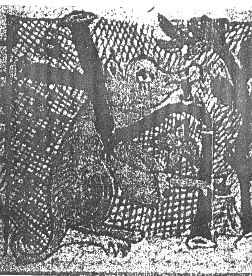Another Scottish Piping Pig
Tom Hughes will be well-known to pipers in England, but his move to Dumfries last year has resulted in the count of carvings of pipers in Scotland increasing by 10%
One of the first things I wanted to do when I moved to Dumfries in early 2018 was to find some historic bagpipe connections with the town. I was quickly able to find a couple of references of payments to “pyparis” during James IV’s stay in the town in 1504 and a visit of The Wandering Piper in 1830 during his tour of Britain. But most of all I wanted to find a carving of a bagpiper, then after visiting all the medieval ruins in the region, I thought I would be disappointed. Before long though I started working on the Dumfries Stonecarving Project, run by the Dumfries Historic Buildings Trust, to draw awareness to the carved sandstone heritage of the town.
Thanks to the high quality of the sandstone in the area, there were important quarrying and decorative stone carving industries in Dumfries, with the stone exported across the world as well as many fine buildings in the town centre being constructed in this material. We have worked with lots of volunteers, many of them from local camera clubs to record the stone carvings around the town centre. We weren’t however expecting much older than the 18th century. Being a border town has meant that Dumfries was burned several times in the late medieval period. Although the town layout still follows the medieval plan, the only structure surviving from that date is the mid-15th century bridge.
But there, among the photographs from one of our first surveys was a bagpiping pig, seemingly medieval, high up above the street level and so missed by pedestrians. Indeed, the significance would likely have been missed by the project were it not for the serendipity of having a bagpipe fanatic on the team. The carving depicts a pig playing a single chanter instrument, with a single drone over its shoulder. It’s not as pig-like as it might be, and indeed some people suggested that it could be a cow, but the lack of udder and arrangement of teats definitely resembles a sow rather than cow. Pigs, usually sows, are a fairly common piping motif. This piping pig carving is now a skewput at 66 Queensberry Street, Dumfries; at the time of writing the building is a café called Lugano’s. Of course, we started telling people, and at a talk I gave about bagpipe carvings, a gentleman in the audience had a striking look of realisation on his face. He told me he was the brother of the café owner and he could now explain to his sister why so many people were now stopping and looking up at the top of her building!
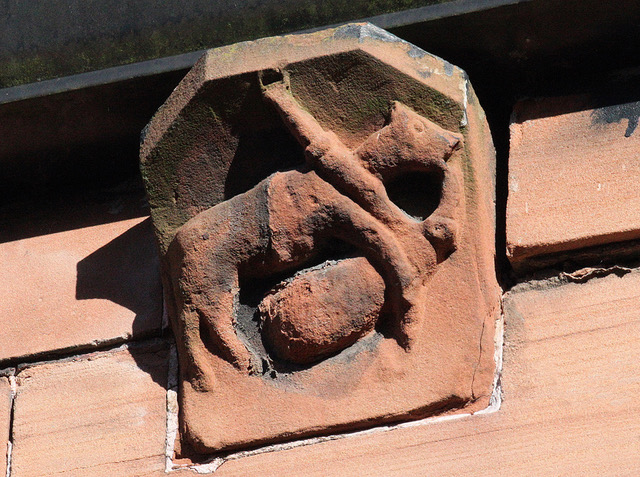
Based on the style of the carving and comparison with others, it looks likely to be late 14th century, early 15th century. It seems to have been originally an eaves corbel. The sandstone appears to have come from the Castledykes quarry, which was the medieval quarry at the edge of the town. There were few stone buildings in medieval Dumfries; Greyfriars Monastery, which was founded in the 13th century, and a few churches, though none of these were close to the current site of the pig. But the present location of the carving is a late 19th century building across the road from the site of a structure which was known as the New Wark. This was a stone tower with similar appearance to Threave Castle in Galloway. The New Wark was built in the late 14th century as a defensive structure which incorporated a prison and barracks. Much of it was pulled down in 1764 and the rubble was left in a pile in what would become Queensberry Square, so that it could be used as a sort of quarry for the town. The remainder of the building was removed in 1846. Given the dates of this building along with the location, it seems a very likely place for the pig piper to have originated.
The building alongside the current site of the pig piper was formerly a pub called the Foresters Arms, which in the early 20th century was locally known as the pig and bagpipes. The facade of the pub collapsed in the 1920s and so there's a small chance that the carving had been moved there before being rescued again, though it looks like it has been in its current location since that building was constructed, so it could have had the nickname from the carving which was on the neighbour’s roofline.
Since this carving has come to attention again, many people have asked why a pig should be playing bagpipes. Of course the bagpipe playing pig at Melrose Abbey is perhaps the best known early depiction of a bagpipe in Scotland, featuring on postcards and fridge magnets as well as a lot of Historic Scotland’s publicity so we shouldn’t be too surprised. Indeed, when you start looking, (and The Bagpipe Map website is a fantastic help), piping pigs turn out to be surprisingly common across Europe.
After “Are those Northumbrian pipes?”, probably the next most common question I get asked when playing in front of the general public is “That’s made from a pig’s bladder isn’t it?”. I’m sure many other bagpipers have experienced the same.
It seems there is quite a strong link between pigs and bagpipes in many people’s minds, even those who may not have much occasion to think of the instrument and I often wonder why this should be. To give an example, a few years ago I was at a fancy dress barbeque – and although I happily spend many working days in some historic costume or other I still cringe a little at this type of party – and a session was just starting. Someone arrived who happened to be dressed as a giant pink pig and spotting my smallpipes he immediately ran over to me and grabbed the bag wailing, “My brother, what have you done to my brother?!”
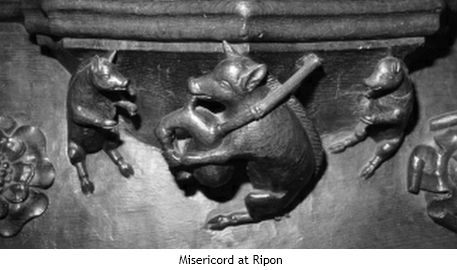
We can find other medieval woodcarvings of piping pigs. For example, a pulpit in St Leonard’s, Ribbesford, in Worcestershire has a pig playing a double chanter bagpipe which is very similar in design to misericords of piglets dancing to piping sows at Ripon, Richmond and Manchester, though the Ribbesford version is a flatter relief as it was formerly part of the rood screen.
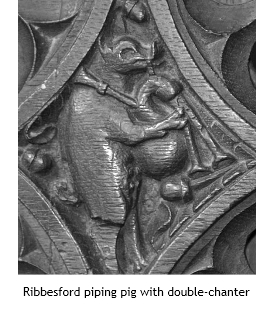
And it’s not just in Britain that we find this association. There is an example of Danish bagpiping bacon on a wall painting in Vestervig church as well as Dutch 15th century pewter badges of piping pigs that have been found in Utrecht and Amsterdam and in illuminated manuscript form in the exquisite Tres Riches Heures du Duc de Berry from early 15th century France.
It’s worth remembering that pigs are not the only members of the animal kingdom that play bagpipes in the imaginative work of medieval artists, there are also several examples of piping apes and a couple of asses too, though not so many in number as pigs. Similarly, pigs can be found playing other instruments on occasion, including organs and harps, though they seem to favour the bagpipes most of all.
If we look to other animals and other instruments, there is also quite an association between cats and fiddles. This is most commonly known through a nursery rhyme, but also through misericords and medieval manuscripts, as we find with our pigs and bagpipes. Perhaps here we have a connection with common misconceptions about how these particular instruments are constructed, so whilst people may think the bag is made from a pig’s bladder, then they may also believe the fiddle has strings made from cat gut. So the depictions could represent the animals playing the instruments made from parts of themselves, a visual pun.
However, there is perhaps more of a connection to the sound of these instruments when played badly. So we could imagine the scratching of the strings of a fiddle being reminiscent of a cat’s night-time wailing, or a bagpipe resembling the squealing of a pig. I could believe that there was once a well-known folk tale or joke that ran along these lines, but that it is lost to us today.
Alfred Hitchcock’s oft-quoted joke about bagpipes may be worth repeating to illustrate this particular point. “I understand the inventor of the bagpipes was inspired when he saw a man carrying an indignant, asthmatic pig under his arm. Unfortunately, the man-made sound never equalled the purity of the sound achieved by the pig.” But certainly the best example of the joke about a bagpipe-pig connection is the medieval misericord from Lavenham in Suffolk, showing a man playing the double chanter pig pipe.
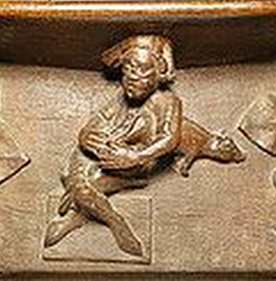
As to why pigs should be associated with bagpipes, there seem to be many opinions, often contradictory. For example in reading around the subject I have found people suggesting that it is because pigs are most like humans, they are intelligent and jolly and content with their life, whilst elsewhere there are those who say that pigs play bagpipes because they are symbols of greed, lust and idleness and so they should play such a base instrument so commonly linked with devils. I’m sure that fellow bagpipers would agree with the former – the pigs are clever and cheerful. With that in mind, I’m delighted that my nearest bagpipe carving is the piping pig of Dumfries.
Two more piping pigs from Scotland and one from Ireland; clockwise from right:
1 Detail from a possibly 16th-century manuscript of a Dinnseanchas, an Irish topographical history.

2. Melrose Abbey, probably early 15th century (the abbey was rebuilt after a fire in 1385)
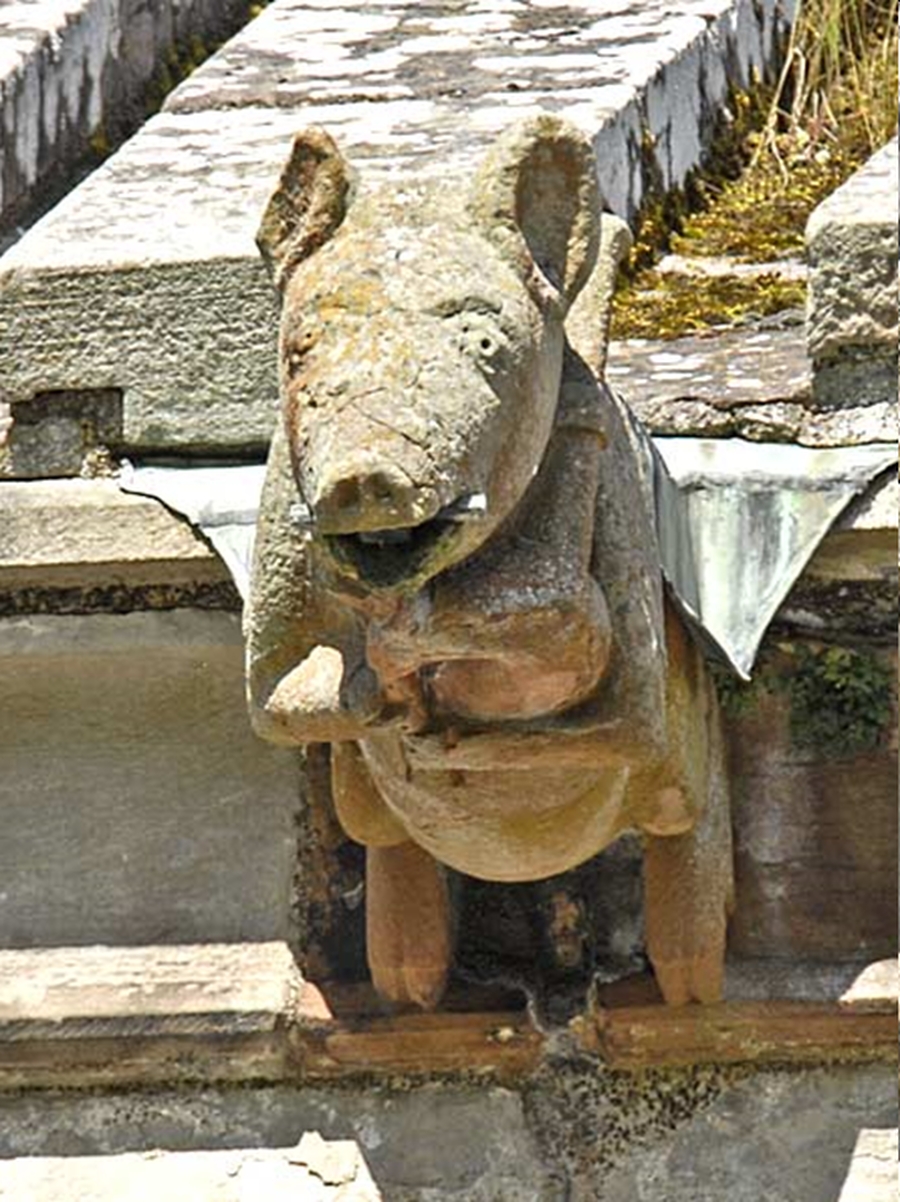
3. From The Wode Psalter, c.1590 The original is a colour vignette amongst the notation of a psalm: (image courtesy of Keith Sanger). Possibly the earliest appearance in Scotland of a second drone.
